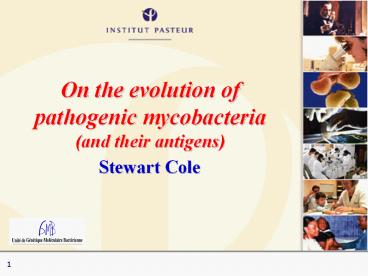On the evolution of pathogenic mycobacteria (and their - PowerPoint PPT Presentation
1 / 37
Title:
On the evolution of pathogenic mycobacteria (and their
Description:
On the evolution of pathogenic mycobacteria (and their antigens) Stewart Cole Phylogenetic tree - slow growers Unanswered questions PE, PPE & ESX gene families occupy ... – PowerPoint PPT presentation
Number of Views:83
Avg rating:3.0/5.0
Title: On the evolution of pathogenic mycobacteria (and their
1
On the evolution of pathogenic mycobacteria(and
their antigens)
Stewart Cole
2
Phylogenetic tree - slow growers
Tuberculosis
M. tuberculosis
M. africanum
M.canettii
M. microti
M. bovis
M. bovis BCG
Leprosy
Springer et al., J. Clin. Microbiol., (1996)
34296-303
3
Mycobacterial cell envelope
4
Genome of M. tuberculosis
Maps of other spp. nearly identical
4,000 genes 40 orphans
Cole et al. (1998) Nature 393 537-544
5
Duplicated proteins in M. tb.
Tekaia et al. (1999) Tuber Lung Dis 79, 329-342.
200
Number of partitions
100
0
Number of genes
6
Unanswered questions
- PE, PPE ESX gene families occupy 10 of genome
- What do they do?
- Involved in pathogenesis /or persistence?
- Immune evasion, antigenic variation?
7
Domain structure of PE PPE proteins
94-110 aa
170-588 aa
Unique sequence
40-1680 aa
7-314 aa
PGRS
(GGAGGAGGN)n
200-3500 aa
180 aa
(NXGXGNXG)n
MPTR
200-400 aa
GxxSVPxxW
0-400 aa
Unique
8
Some PE-PGRS surface-located variable
Immunogold EM
Western blot cell envelope proteins from
clinical isolates
Banu et al. 2002 Mol. Microbiol. 44 9-19
9
Variability in PE genes
PE_PGRS family Same thing seen with PPE_MPTR
10
PGRS gene conversion?
11
Impact on innate immunity?
In-frame deletion-variants have altered effects
12
PE-PGRS inhibit proteasomes
Brennan et al. (2002) TIMS 10, 246
13
What is the role of the PE-PGRS?
- Purely structural
- Innate immunity via TLR2
- Variable surface antigen
- Immunological smoke-screen
- Proteasome inhibitor, cf EBNA-1
- Blocks ag presentation by MHC class I
14
Immunogenicity islands
N5
Envelope T-cell antigens
Major, secreted T-cell antigens
N6
15
RD1 in M. bovis BCG ESX-1
Rv3876
Rv3860
PE/PPE
Rv3869
Rv3868
Rv3866
esx
Rv3864/65
Rv3867
Rv3863
Rv3861
Rv3870
Rv3874
Rv3877
Rv3878
Rv3871
4336
4354
4353
4352
4351
4350
4349
4348
4347
4346
4345
4344
4343
4342
4341
4340
4339
4338
4337
4355
4356
4357
4358
4359
4360
4361
4362
4363
4364
4365
4366
4367
4368
4369
4370
4371
4372
Rv3884
Rv3862
Rv3879
Rv3885
Rv3882
Rv3886
Rv3880
Rv3881
Rv3883
Rv3887
ESAT-6 locus of Tekaia et al.
Rv3872 PE Rv3873 PPE Rv3874 CFP10 Secreted T
cell antigen Rv3875 ESAT-6 Secreted T cell
antigen Rv3876 ATPase Rv3877 Integral
membrane protein Rv3878 Unknown Rv3879 Unknown
-Proline rich N-terminal
16
ESX-1 increases virulence in SCID mice
17
Model for ESX-1 function
Secretes major T-cell antigens Required for
uptake cell-cell spread
Pym et al. (2002) Mol Microbiol 46 709 Pym et
al. (2003) Nat Med 14 533 Brodin et al. (2004)
J Inf Dis 190 115 Brodin et al. (2005) J Biol
Chem. 280 33953 Renshaw et al. (2005) EMBO J.
24 2491-8.
18
M. leprae - genome decay
Slide 12
Slide 12
19
Comparative genomics M. tb - M. leprae
Mycobacterium tuberculosis
Alpha, keto methoxy- mycolates
secA
trpT
nusG
rplK
rplA
mmaA4
lipG
mmaA1
Rv0647
mmaA3
mmaA2
Mycobacterium leprae
No methoxy- mycolates
nusG
rplK
secA
trpT
rplA
pseudo
MLCB41.12
mmaA1
lipG
MLCB41.06
mmaA4
pseudo
pseudo
20
Gross features of M. leprae genome
- 1,605 genes
- 1,433 genes common with M. tub.
- gt1,116 pseudogenes
- 1,500 genes "deleted "
- 160 M. lep "specific" genes
- Mosaic, 65 segments M. tub
M. leprae has undergone reductive
evolution Rep-DNA involved
21
Main IS repeats in M. leprae
- 2 of genome made of repeats
- 26 different IS, all defective
- RLEP (37 copies, gt 1 truncated, 850 bp)
- REPLEP (15 copies, 2 truncated, 881 bp)
- LEPREP (8 copies, 3 truncated, 2383 bp)
- LEPRPT (5 copies, 2 truncated, 1252 bp)
- None has ORFs, some have IR
22
What happened to synteny?
Recombination between rep-DNA
Rv1056 Rv0409, Rv0408
(ackA, pta)
M. tuberculosis
ML0266 REPLEP ML0267, ML0268
M. leprae
23
Deletions mediated by REPLEP?
M. leprae then
24
Depleted PE/PPE repertoire in M. leprae
Esx repertoire reduced. Esx1, 3 2(PE,PPE,Esx2)
25
Mycobacterial phylogeny
26
Buruli ulcer - an emerging disease
- No therapy
- No vaccine
- Surgery grafts
- Painless, no IR
- Not transmissible
- between humans
27
Mycolactone
Mycolactone - an assembly-line product
28
Transmission of M. ulcerans
Naucoris cimicoides
Larvae? Molluscs? Fish? Ducks?
Marsollier, L., et al. (2002) Aquatic insects as
a vector for Mycobacterium ulcerans. Appl
Environ Microbiol 68, 4623-8.
29
The M. ulcerans genome
30
First mycobacterial virulence plasmid
Stinear et al. 2004 PNAS 101 1345
31
Giant PKS produce mycolactone
Locus arose by duplication 16 tandem repeats
32
Bipartite whole genome comparison
gt98 sequence ID 213 x IS2404, 91 x IS2606
Stinear et al. (2007) Genome Res 17 192-200.
33
Some genome statistics
M. marinum M. ulcerans Chromosome
size 6,636,827 5,631,606 Genes 5,434 4,160
Pseudogenes 52 771 GC 65.73 65.71 Gen.
Time (h) 4 36
34
Depletion of PE, PPE, ESX repertoire
35
Where did M. ulcerans come from?
- Derived from MM after acquiring
- plasmid with genes for mycolactone
- But pMUM001 may be mosaic
http//genstyle.imed.jussieu.fr/
. and have introduced IS elements
36
Evolutionary driving forces?
- Environmental ancestor, large genome
- Lots of PE, PPE, ESX?
- Change in environment
- Stable niche, genome degenerates, rep-DNA
involved
- In host, lose PGRS, ESX etc.
- Selection for less immunogenic, less virulent
variants?
37
With the participation of...
Institut Pasteur S. Banu R. Brosch K.
Eiglmeier T. Garnier N. Honoré L. Marsollier G.
Meurice M. Monot A.S. Pym G. Reysset T. Stinear
Collaborators B.G. Barrell S.V. Gordon R.G.
Hewinson J. Parkhill L. Ramakrishnan P.L.C. Small
NIH NIAID
ILEP
AFRF































